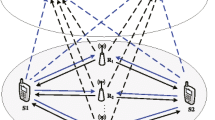Abstract
This paper investigates the energy efficient resource allocation scheme for orthogonal frequency division multiplexing based heterogeneous cognitive radio network (HCRN) under imperfect spectrum sensing scenario with guaranteed quality of service (QoS). The objective of this paper is to maximize the energy efficiency (EE) of the HCRN subject to total transmission power, interference and QoS Constraints. To solve the mixed integer nonlinear programming problem efficiently, the primal problem has been transformed into a linear programming problem by separating the resource allocation scheme into two steps, i.e., subcarrier assignment and power allocation. Consequently an energy efficient power allocation (EEPA) algorithm has been anticipated based on fractional programming and sub-gradient method. Numerical results confirm that the proposed EEPA algorithm can achieve higher EE than conventional equal power allocation method.







Similar content being viewed by others
References
Federal Communications Commission Spectrum Policy Task Force. (2002). Report of the spectrum efficiency working group. http://www.fcc.gov/sptf/reports.html.
Mitola, J. (2002). Cognitive radio—an integrated agent architecture for software defined radio: 0474–0474. Stockholm: Royal Institute of Technology.
Mitola, J., & Maguire, G. Q. (1999). Cognitive radio: Making software radios more personal. IEEE Personal Communications,6(4), 13–18.
Haykin, S. (2005). Cognitive radio: Brain-empowered wireless communications. IEEE Journal on Selected Areas in Communications,23(2), 201–220.
Zhu, X., Shen, L., & Yum, T. S. P. (2007). Analysis of cognitive radio spectrum access with optimal channel reservation. IEEE Communications Letters,11(4), 304–306.
Subhedar, M., & Birajdar, G. (2011). Spectrum sensing techniques in cognitive radio networks: a survey. International Journal of Next-Generation Networks,3(2), 37–51.
Pandit, S., & Singh, G. (2017). Spectrum sensing in cognitive radio networks: potential challenges and future perspective. In Spectrum sharing in cognitive radio networks (pp. 35–75). Cham: Springer International Publishing.
Ali, A., & Hamouda, W. (2016). Advances on spectrum sensing for cognitive radio networks: Theory and applications. IEEE Communications Surveys & Tutorials,19(2), 1277–1304.
Suliman, I., Lehtomäki, J., Bräysy, T., & Umebayashi, K. (2009). Analysis of cognitive radio networks with imperfect sensing. In 2009 IEEE 20th international symposium on personal, indoor and mobile radio communications (pp. 1616–1620). IEEE.
Altrad, O., Muhaidat, S., Al-Dweik, A., Shami, A., & Yoo, P. D. (2014). Opportunistic spectrum access in cognitive radio networks under imperfect spectrum sensing. IEEE Transactions on Vehicular Technology,63(2), 920–925.
Aruna, T., & Suganthi, M. (2012). Variable power adaptive MIMO OFDM system under imperfect CSI for mobile ad hoc networks. Telecommunication Systems,50(1), 47–53.
Jung, E., & Liu, X. (2008). Opportunistic spectrum access in heterogeneous user environments. In 3rd IEEE symposium on new frontiers in dynamic spectrum access networks, 2008. DySPAN 2008 (pp. 1–11). IEEE.
Yang, G., Wang, J., Luo, J., Wen, O. Y., Li, H., Li, Q., et al. (2016). Cooperative spectrum sensing in heterogeneous cognitive radio networks based on normalized energy detection. IEEE Transactions on Vehicular Technology,65(3), 1452–1463.
Georgel, G. T., & Jayasheela, M. M. (2013). Performance of OFDM-based cognitive radio. International Journal of Engineering Science Invention, 2(4), 51–57.
Zhang, Y., & Leung, C. (2009). Resource allocation in an OFDM-based cognitive radio system. IEEE Transactions on Communications,57(7), 1928–1931.
Awoyemi, B. S., Maharaj, B. T., & Alfa, A. S. (2017). Resource allocation in heterogeneous cooperative cognitive radio networks. International Journal of Communication Systems,30(11), e3247.
Adian, M. G., Aghaeinia, H., & Norouzi, Y. (2016). Optimal resource allocation for opportunistic spectrum access in heterogeneous MIMO cognitive radio networks. Transactions on Emerging Telecommunications Technologies,27(1), 74–83.
Awoyemi, B., Maharaj, B., & Alfa, A. (2017). Optimal resource allocation solutions for heterogeneous cognitive radio networks. Digital Communications and Networks,3(2), 129–139.
Li, M., Hei, Y., & Qiu, Z. (2016). Joint sensing and power allocation in wideband cognitive radio networks. Telecommunication Systems,62(2), 375–386.
Wang, S., Zhou, Z. H., Ge, M., & Wang, C. (2012). Resource allocation for heterogeneous multiuser OFDM-based cognitive radio networks with imperfect spectrum sensing. In INFOCOM, 2012 proceedings IEEE (pp. 2264-2272). IEEE.
Gür, G., & Alagöz, F. (2011). Green wireless communications via cognitive dimension: an overview. IEEE Network,25(2), 50–56.
Chatterjee, S., Maity, S. P., & Acharya, T. (2014). Energy efficient cognitive radio system for joint spectrum sensing and data transmission. IEEE Journal on Emerging and Selected Topics in Circuits and Systems,4(3), 292–300.
Sun, X., & Wang, S. (2017). Energy‐efficient power allocation for cognitive radio networks with minimal rate requirements. International Journal of Communication Systems,30(2), e2953.
Wang, S., Shi, W., & Wang, C. (2015). Energy-efficient resource management in OFDM-based cognitive radio networks under channel uncertainty. IEEE Transactions on Communications,63(9), 3092–3102.
Wang, Q., Zou, Y., & Zhu, J. (2016). A multi-band power allocation scheme for green energy-efficient cognitive radio networks. In 2016 8th international conference on wireless communications & signal processing (WCSP) (pp. 1–5). IEEE.
Pei, Y., Liang, Y. C., Teh, K. C., & Li, K. H. (2011). Energy-efficient design of sequential channel sensing in cognitive radio networks: Optimal sensing strategy, power allocation, and sensing order. IEEE Journal on Selected Areas in Communications,29(8), 1648–1659.
Kha, H. H., Vu, T. T., & Do-Hong, T. (2017). Energy-efficient transceiver designs for multiuser MIMO cognitive radio networks via interference alignment. Telecommunication Systems, 66(3), 1–12.
Shi, Z., Teh, K. C., & Li, K. H. (2013). Energy-efficient joint design of sensing and transmission durations for protection of primary user in cognitive radio systems. IEEE Communications Letters,17(3), 565–568.
Feng, L., Kuang, Y., Fu, X., & Dai, Z. (2016). Energy-efficient network cooperation joint resource configuration in multi-RAT heterogeneous cognitive radio networks. Electronics Letters,52(16), 1414–1416.
Shi, Y., & Hou, Y. T. (2008). A distributed optimization algorithm for multi-hop cognitive radio networks. In INFOCOM 2008. The 27th conference on computer communications (pp. 1292–1300). IEEE.
Boyd, S., & Vandenberghe, L. (2004). Convex optimization. Cambridge: Cambridge University Press.
Dinkelbach, W. (1967). On nonlinear fractional programming. Management Science,13(7), 492–498.
Author information
Authors and Affiliations
Corresponding author
Additional information
Publisher's Note
Springer Nature remains neutral with regard to jurisdictional claims in published maps and institutional affiliations.
Rights and permissions
About this article
Cite this article
Thangaraj, C.A., Aruna, T. Energy-Efficient Power Allocation with Guaranteed QoS Under Imperfect Sensing for OFDM-Based Heterogeneous Cognitive Radio Networks. Wireless Pers Commun 109, 1845–1862 (2019). https://doi.org/10.1007/s11277-019-06655-w
Published:
Issue Date:
DOI: https://doi.org/10.1007/s11277-019-06655-w




